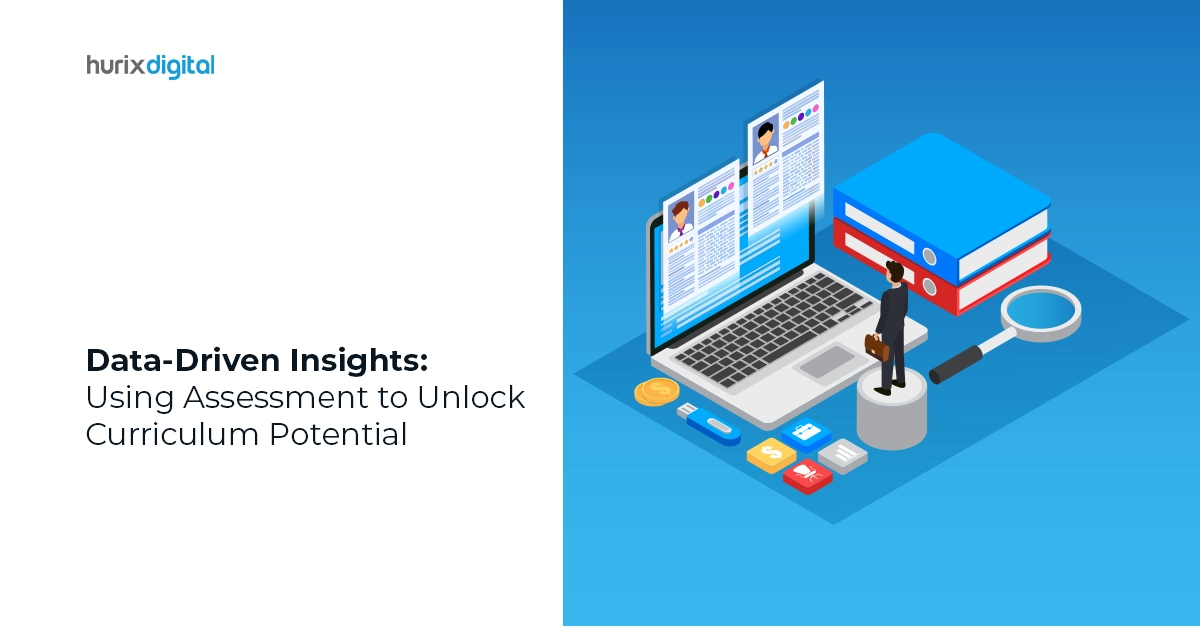Data-Driven Insights: Using Assessment to Unlock Curriculum Potential
Forget the monotony of rote learning and picture a classroom buzzing with intellectual energy. Students with different perspectives engage in lively debates, tackle projects together and solve problems with creativity. This vibrant learning landscape isn’t a dream; it’s the result of a curriculum optimized by the powerful tool of assessment.
Table of Contents:
- Why do we Need to Recalibrate our Curriculum Creation Process?
- How to Use Assessments to Enhance Your Curriculum?
1. Identifying Learning Objectives: The Blueprint
2. Choosing the Right Tools: A Diverse Toolbox
3. Data Analysis: From Raw Material to Insights
4. Curriculum Enhancement: Chiseling Away
5. Continuous Feedback Loop: The Never-Ending Journey - Unleashing the Potential of Every Learner: Your Partner in Curriculum Craftsmanship
Why do we Need to Recalibrate our Curriculum Creation Process?
The future of k-12 learning demands a revolution in our approach to curriculum development. The traditional, static model simply can’t keep pace with the ever-evolving needs of 21st-century learners and the rapid advancements in technology and knowledge. An effective learning model is personalized, inclusive and student centered, with interactive displays, collaborative projects, and students passionately delving into real-world challenges.
Emerging trends, like personalized learning, project-based learning, and social-emotional learning, are reshaping the educational landscape. Curriculum development is no longer about cramming a fixed set of facts into young minds; it’s about nurturing critical thinking, fostering collaboration, and equipping students with the adaptability to thrive in a dynamic world. Assessments, too, are evolving beyond standardized tests, embracing diverse tools like self-reflection, peer feedback, and portfolios to paint a rich picture of individual learning journeys. This dynamic interplay between evolving trends, innovative curriculum design, and data-driven assessments lies at the heart of the education revolution we desperately need.
Curriculum development is no longer seen as a rigid system, forcing knowledge on learners. And assessments have evolved from a mere measuring stick into a dynamic chisel, revealing not just what students know, but how they learn. It’s a multifaceted lens through which we can determine and enhance curriculum potential, ensuring every student finds their own path to understanding.
So, how exactly do we use this catalyst?
How to Use Assessments to Enhance Your Curriculum?
1. Identifying Learning Objectives: The Blueprint
Every great masterpiece starts with a clear vision – what do we want our students to know, understand, and be able to do? By articulating specific learning objectives, we lay the foundation for our assessment strategies. These objectives become our guiding compass, ensuring every assessment tool, be it formative or summative, aligns with the desired learning outcomes.
Also Read: The Importance of Curriculum Planning for Effective Learning
2. Choosing the Right Tools: A Diverse Toolbox
Just like a sculptor wouldn’t rely solely on a hammer, effective assessment requires a diverse toolbox. Formative assessments, like quick quizzes, in-class discussions, and observations, offer real-time glimpses into student progress, revealing areas of mastery and highlighting potential stumbling blocks. Conversely, summative assessments, like essays, presentations, and exams, provide broader snapshots of overall learning, allowing us to gauge understanding and identify broader trends.
3. Data Analysis: From Raw Material to Insights
Assessment data, like raw marble, holds immense potential, but needs skilled hands to bring its beauty to light. Data analysis is the process of transforming this raw material into actionable insights. By scrutinizing quiz results, analyzing project artifacts, and interpreting observational notes, we can identify patterns, clarify misconceptions, and pinpoint areas where our curriculum needs curriculum enhancement.
4. Curriculum Enhancement: Chiseling Away
Armed with the insights gleaned from data analysis, we can now embark on the crucial process of curriculum enhancement. This is where the sculptor’s vision truly shines. We might need to add enriching resources, adjust the sequence of topics, or design new activities that target specific learning gaps. The key is to use data-driven decisions to refine and shape the curriculum into a platform that fosters engagement, critical thinking, and caters to diverse learning styles.
5. Continuous Feedback Loop: The Never-Ending Journey
Curriculum development is not a static portrait; it’s a dynamic symphony where each assessment stroke informs the next, creating a continuous cycle of improvement. This feedback loop ensures that our curriculum remains responsive to the ever-evolving needs of our students, constantly revising and adapting to nurture their unique learning journeys.
Also Read: 10 Best Digital Assessment Tools That Are Useful for Both Students As Well As Teachers
Unleashing the Potential of Every Learner: Your Partner in Curriculum Craftsmanship
As educators, we strive to create classrooms where every student feels empowered to explore, discover, and express their unique understanding. Using curriculum assessment as a transformative tool to sculpt and refine our curriculum is a powerful step in this direction.
At Hurix Digital, we offer a comprehensive palette of AI powered assessment solutions, from interactive quizzes and project rubrics to insightful data analysis platforms and a thriving community of educators sharing best practices. Let us work together to transform your curriculum.

Senior Vice President – Business Development
Over 25 years of experience in the edtech and workforce learning industry with strong skills in Business Development, Customer Relationship Management (CRM) and Strategy.









